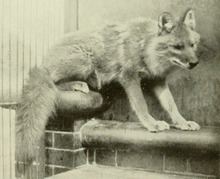Rank Subspecies | Phylum Chordata Genus Cuon | |
 | ||
Similar Ussuri dhole, Sumatran dhole, Five‑toed pygmy jerboa, Gray marmot, Sciurognathi | ||
The Tien Shan dhole (Cuon alpinus hesperius), also known as the Siberian wild dog, Western Asiatic dhole, or Northern dhole is a possible subspecies of dhole native to the Altai and Tien Shan mountain ranges, and possibly Pamir and Kashmir.
Contents
Characteristic
The Tien Shan dhole is somewhat smaller than the Ussuri dhole, with a relatively wider skull and much lighter, straw-coloured winter fur coat. It has a short, wide face and a skull measuring 180 mm long on average. The top of the head and outer sides of the ears are reddish-straw coloured. The upper surface of the neck is dirty-white, with a narrow, sandy-yellow-coloured band running along the upper surface of the back from the ears to the shoulders. The outer surfaces of the limbs are sandy-yellow, while the flanks and inner sides of the limbs have little to no yellowish tint.
Distribution and habitat
The Tien Shan dhole's habitats consists of mountain ranges and other areas with colder climate. It currently lives in Tien Shan and Altai mountains.
The dhole was once widespread from Northeast to southern Central Asia in Transoxiana. They formerly lived in Siberia, Mongolia, Kazakhstan, Kyrgyzstan and Turkmenistan. The Tian Shan dhole still occur in Tibet. A few still live in the Gansu Province from northwestern China. Although dholes have not been recorded in Pakistan, they once occurred in the alpine steppes extending into Kashmir.
Hunting and diet
It feeds primarily on Siberian ibexes, arkhar, argali, roe deer, maral and wild boar, as well as musk deer and reindeer.
